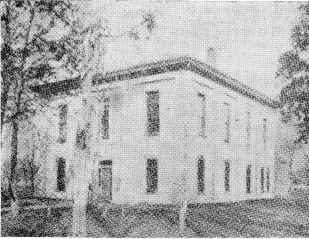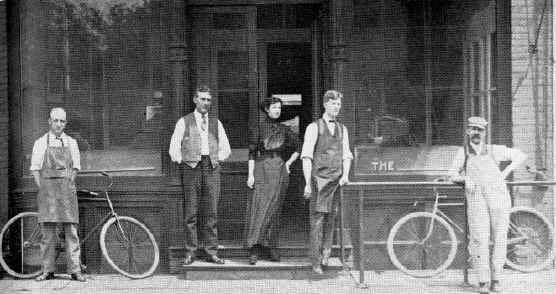
The Old County Court House, at Columbus, built in 1868, accepted June 22, 1870.
NEGenWeb Project
Resource Center
On-Line Library
| 54 | The History of Platte County Nebraska |
The Old County Court House, at Columbus, built in 1868, accepted June 22, 1870. |
The speculative element evidenced in the Black Hills mining promotion and other land exploitation was dwindling by 1890 and the country passed into a period of stabilization marked by low farm prices with a correspondingly low cost of living overhead.
Two large milling companies continued to do the biggest business in town. Farm income, the steadily increasing output of the region which advanced with every mechanical and scientific aid to modern agriculture, continued as the one source of dependable wealth. Even foreign capital was invested in Platte County farm land and real estate business was extremely active, showing from ten to thirty transfers every week.
INTERNATIONAL TRADE
It was in 1892 that Columbus stepped into the international trade field. Several merchants in the grain market exported oats to Switzerland in that year, building up a thriving trans-Atlantic business. Ten business houses and thirty-nine residences were built in 1892 and a tank line established making Columbus a distributing point for oil. After the turn of the century, with the appearance of the automobile, the latter industry expanded enormously.
Columbus was beginning to be aware of her heritage and to properly evaluate the bravery and sacrifice that had gone into her own development. This was the age of silver-tongued oratory and W. N. Hensley, famed for his ability to charm an audience, spoke before the 1892 Columbus Day celebration, which marked the four hundredth anniversary of the discovery of America. Parades with floats representing all the nationalities of Platte County swept through the streets of Columbus and the affair was attended by citizens from all over the county.
Cultural values were probably esteemed more highly in the early 1890's than at any previous time. Lectures, concerts and visiting artists and musical organizations presented almost a constant round of professional entertainment and local amateur performances were frequent and well attended.
Meanwhile, out in the farming communities,, men were beginning to encourage the cultivation of hemp on a commercial basis and the infamous Russian Thistle pest began to die out as modern ways of eradication came into use. The mighty agricultural empire of Nebraska was evolving out of its domestic status to assume the proportions of an industry and the beginnings of what was to become the biggest business in America.
However, the year 1895 found a drouth affecting the crops of every farm family in the county. Under conditions similar to the great drouth and depression of the early 1930's, the local farmers attempted to weather the bad years through retrenchment, conservation and more immediate financial aid.
Platte County, during those years, did not ask for state aid. Nevertheless, the county board of commissioners appropriated ten thousand dollars from the various funds for relief of the farmers. This relief was given in the form of seed and grain for feed and planting. As the farmers secured the grain, they were required to give a chattel mortgage or lien on their crops, payable in December of that year. A committee of township overseers turned in names of needy farmers to the county aid fund and made collections when due. Only seven hundred and fifty dollars in aid was received from the state to supplement this local program.
Irrigation to combat the after-effects of drouth was one of the most vital problems of the day in the middle '90s. Peter Schmitt, the Shell Creek miller, who was the first farmer to irrigate his acres of corn, had started people talking about water power, and their preliminary talks, in public places and lecture platforms as well as in the columns of the local press, began to analyze the problems of harnessing the waters of the Loup. Also, it was hoped that such a power project would give employment to hundreds of men and teams at a time when wages were down and employment generally off. This was comparable to the drouth period of the 1930's.
During the 1890's, Columbus boasted a wooden shoe factory, a foundry and machine shop, two flour mills, a brewery, creamery, windmill
| The Makings of A Community | 55 |

This photograph was taken in front of the old Telegram office. From left to right: Jacob Brinkman, Lloyd Swain, Hazel From (Mrs. Charles Hirschbrunner), William Gregorius, and Joseph Louis.
factory, several railroad shops and an assortment of varied manufacturing enterprises.
PRESS
The country was well supplied with newspapers including the Columbus Journal, the Platte County Argus and the Columbus Telegram, weekly papers, and the German language paper, the Nebraska Beine, originally the Wochenblatt. The Platte Center Signal was published at Platte Center, the Monroe Republican and the Looking Glass at Monroe, the Humphrey Democrat at Humphrey and the Lindsay Post at Lindsay.
One reason for the tremendous growth of the press in Platte County was the mounting interest of the people in political issues of the day. Railroad legislation and prohibition were two of the paramount questions and the feeling on both sides grew so heated as to be almost fanatical.
POLITICS AND GOVERNMENT
A state election was held in 1895, in which Columbus played a key role, and a national election in 1896 saw four parties participating in opposition to the usual bi-partisan system which characterized the American political arena Democrats, Republicans, Populists and People's Independent parties ran candidates on the ballot. However, the real milestone in this phase of local development came in 1895, in the county election, when a woman, Mrs. Sarah Fitzpatrick Brindley, ran for the office of county superintendent and was defeated by only sixty eight votes. This near-victory was accomplished in spite of the fact that women were not given the vote until some twenty years later and popular prejudice generally held them incapable of filling public offices.
The government both of Columbus and of Platte County was subject to revision in the years which marked their agricultural and commercial ascendancy. Under the original system, Platte County supervisors were made up of a representative from each township. However, on April 11, 1895, the state legislature approved an act to divide counties under township organization into supervisor districts. Platte County was divided into seven supervisor districts in October of that year.
Representing the districts were: D. A. Becher, District 1; Charles O. Moore, District 2; Peter Bettinger, District 3; James Kiernan, District 4; William Schreiber, District 5; Charles A. Speice, District 6; and E. J. Ernst, District 7. The new board met November 12, 1895, and continued in office until the election in November, 1896.
EDUCATION
Keeping pace with the rest of the community development were the educational facilities provided by progressive-minded educators and lay
| © 2005 for the NEGenWeb Project by Ted & Carole Miller |
|||